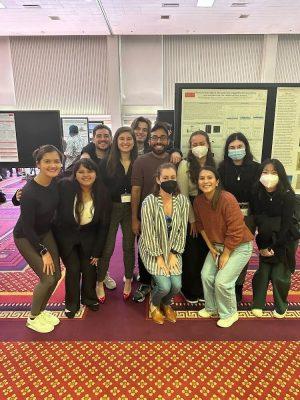
When Steve Ramirez talks about his lab, the Ramirez Group, he doesn’t act like he is the recipient of a million-dollar research grant. Instead, he talks like the coach of a college baseball team.
“My overarching philosophy there of course is really working with this element of camaraderie and team-orientedness,” he said, “and I happen to be the coach of the team, but I’m certainly not the only one involved in the science. It’s the whole group.”
In late October, Ramirez was awarded the $1.15 million Chan Zuckerberg Initiative’s Science Diversity Leadership Award for his project titled “Neuroscience for All: Mapping and Manipulating Neural Memory Circuits in Mice.” Ramirez said this grant allows him to make his lab more focused on making neuroscience research open to students of any background.
“The grant really helps us also focus in on being able to make diversity, equity and inclusion a palpable thing,” Ramirez said. “The money is all going to research and training the next generation of neuroscientists.”
Ramirez and his team, made up of graduate, undergraduate and post-doctoral students and research assistants, study the systems in the brain responsible for memory and the positive or negative associations those memories have. They work with mice to try and modulate the memories to be less negative or more positive.
“I like thinking of the lab as this cohesive team working on the problem that is memory and then different sub teams take on different aspects of memory,” Ramirez said.
The goal of the research is to eventually apply these techniques to modulate memories in human brains — to treat memory diseases like Alzheimer’s, conditions like PTSD or mood disorders like depression, he said.
In terms of inclusion, Ramirez compared neuroscience and academia to a “leaky pipeline,” where there is not enough representation of people from all backgrounds. As a Hispanic American, Ramirez said, “to put it mildly,” there is an underrepresentation of Hispanics and Salvadoran Americans specifically in neuroscience.
“Having people from all sorts of walks of life there makes the lab in and of itself a learning experience, which I think is incredibly valuable,” Ramirez said. “It makes it a more accurate representation of the rest of the world and the people that we’ll work with.”
Michelle Surets, a senior in the College of Arts and Science and team member of the Ramirez Group, said Ramirez focuses on making sure “everyone feels like they have a place in neuroscience.”
“Our lab is one of the few labs that is female dominant, which is very rare for neuroscience, and then we have a lot of diversity on the team themselves,” Surets said “It feels like there’s space in the field for you, which it doesn’t always.”
Team member Rebecca Suthard, a fourth year grad student in the School of Medicine, also emphasized the diversity in Ramirez’s lab.
“Our lab itself, we have people of all varieties, all shapes and colors, and most of our lab is women,” Suthard said. “It’s really unique in that we do have a very diverse group and we use a diverse place and (Ramirez) is also very involved.”
Ramirez’s lab is not just different in terms of representation, Suthard said unlike other research labs, in Ramirez’s lab, undergrads don’t just do “menial” tasks. Ramirez allows them to do “independent project type” work.
“They basically know quite literally how to do everything I know how to do, sometimes better,” Suthard said. “He’s preparing them very well for grad school, med school, whatever they want to do. That is a unique thing.”
Suthard said Ramirez allows her and all the members of the team to “go in a lot of different directions” with research and he is “really open” to new research.
“I’m the first grad student in our lab to do basically glial cell research in the context of what Steve does,” Suthard said. “It initially started as a ha-ha conversation…. and then he was like, ‘Why don’t you try it?”
Ramirez said he is ultimately concerned about the drive and interest researchers have in neuroscience and their ability to work with the group — not their academic abilities or record.
“I don’t think I’ve ever asked any undergrad at the lab in particular, their transcripts or grades or anything like that at all,” he said. “I just find that it doesn’t correlate with just effectiveness as a researcher.”
Ramirez said he hopes to change what the future of the science world looks like, beyond just the discoveries made in his research group.
“One way that we can fix the leaky pipeline in neuroscience and to increase this representation and access to resources… is by recruiting students from underrepresented backgrounds so that we can train in neuroscience and thereby train the next generation,” Ramirez said.

























































































































LMcG • Nov 16, 2022 at 9:04 am
Great to see this important work by undergrads getting featured by the Daily Free Press! Excited to see where they go with this opportunity in the next few years.